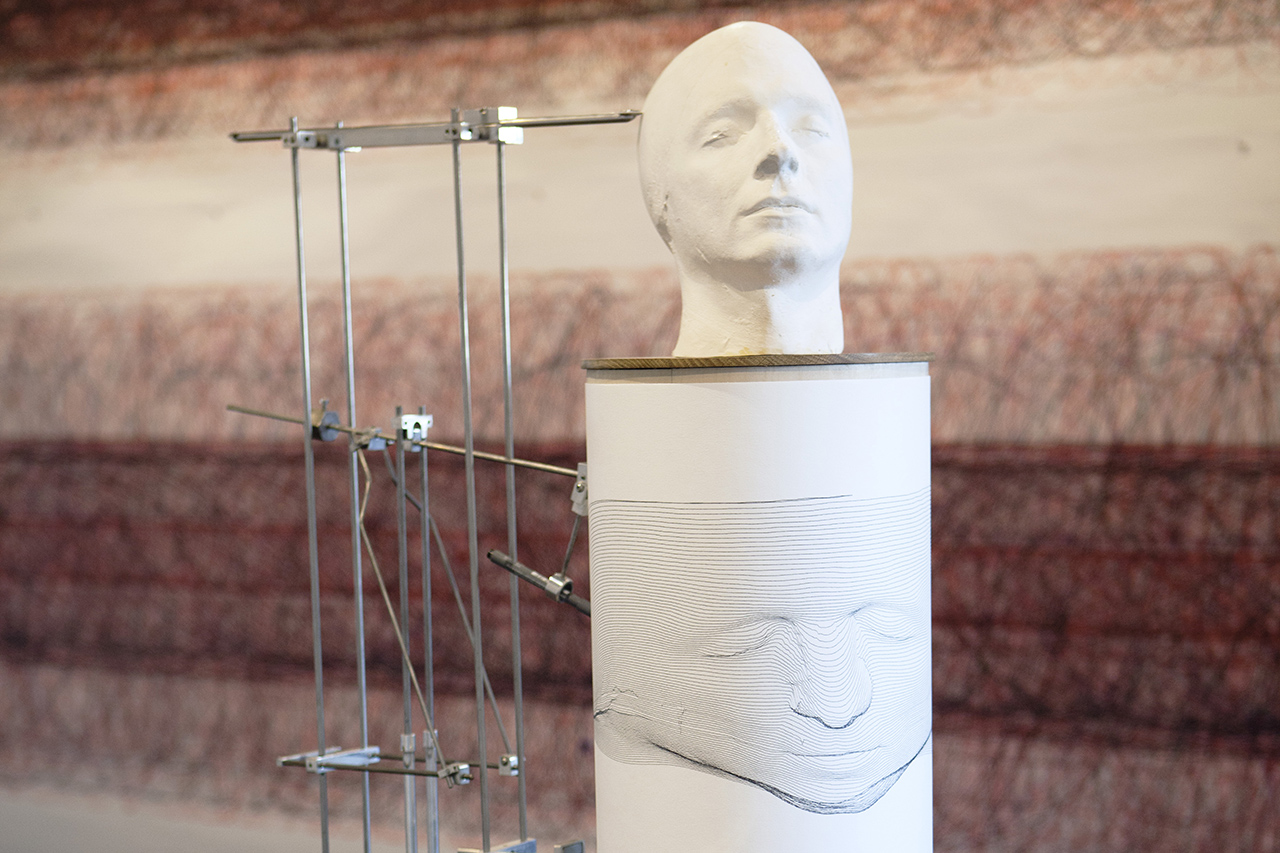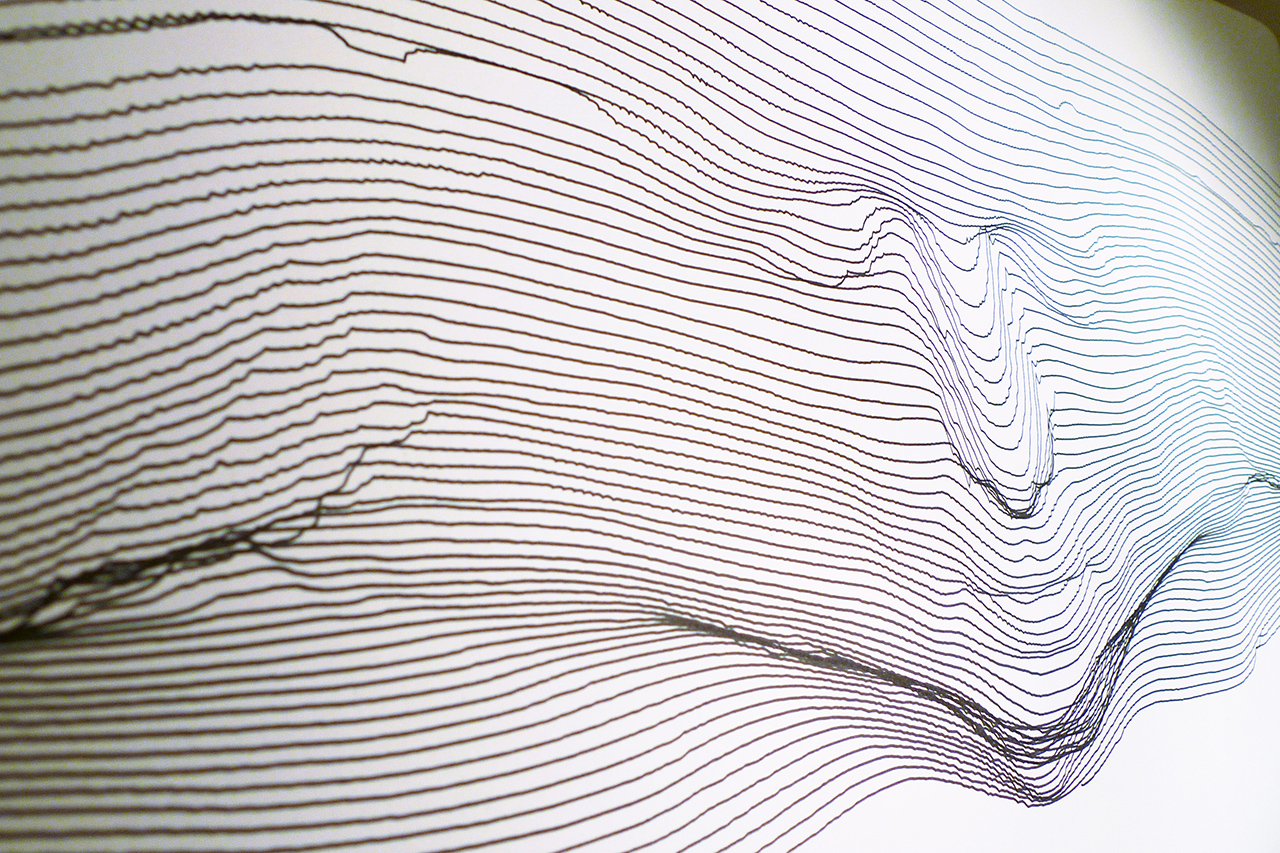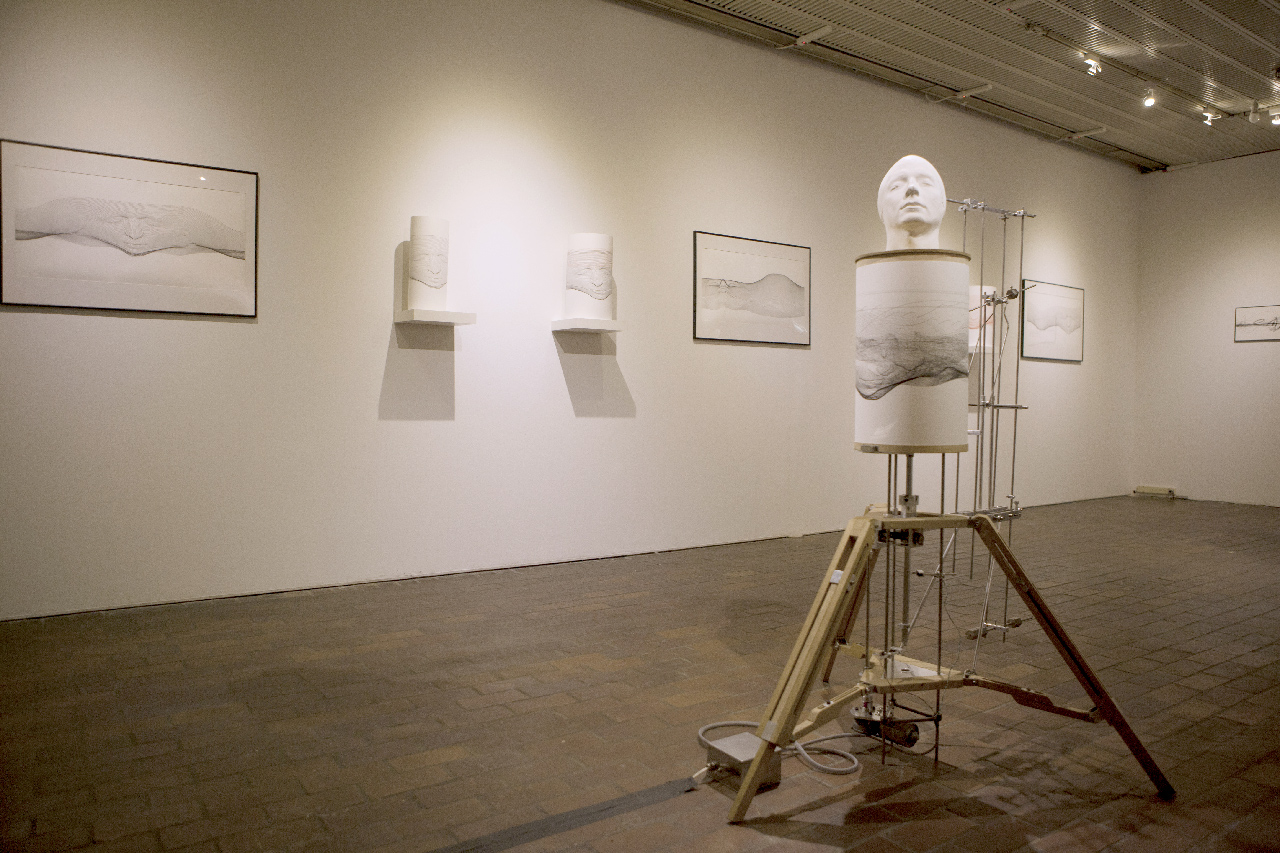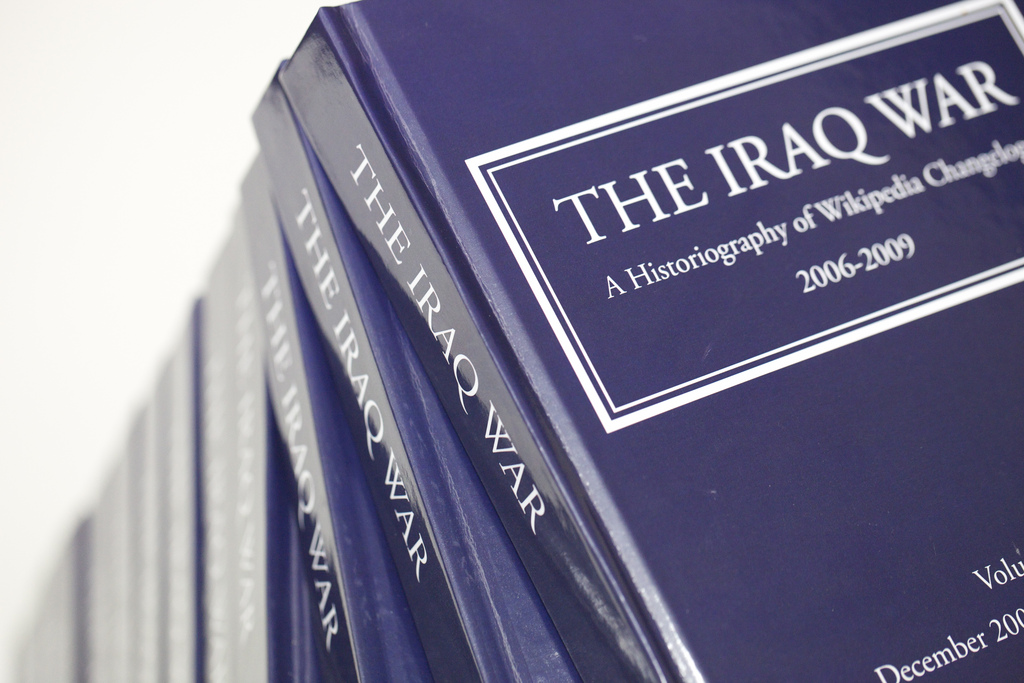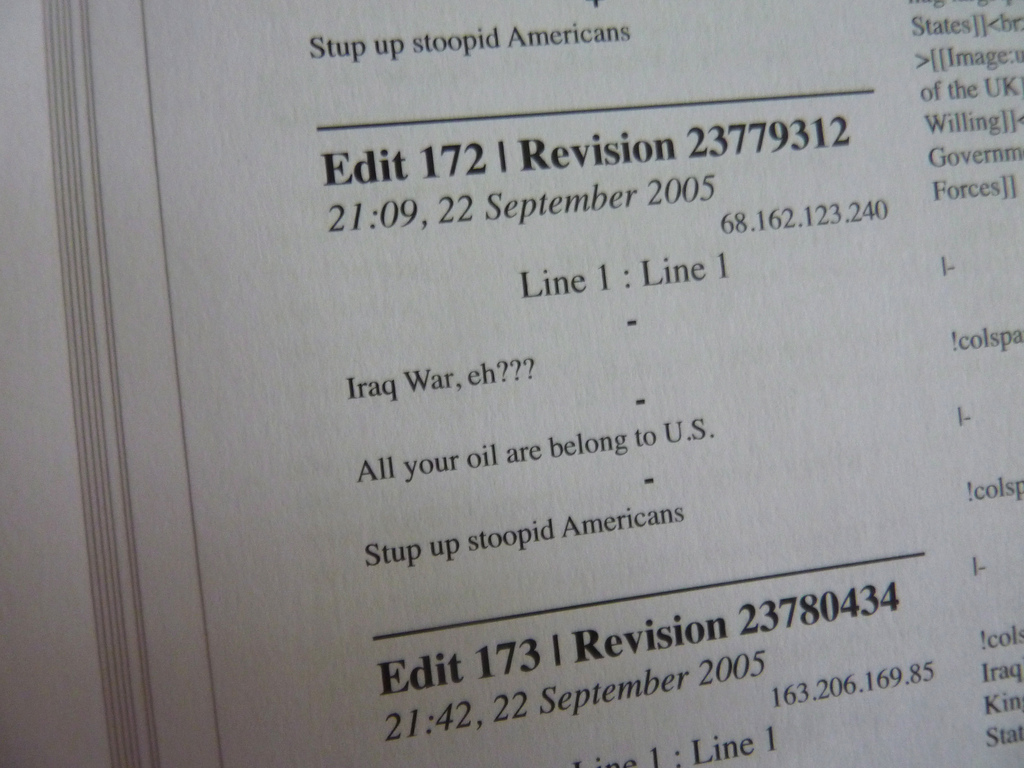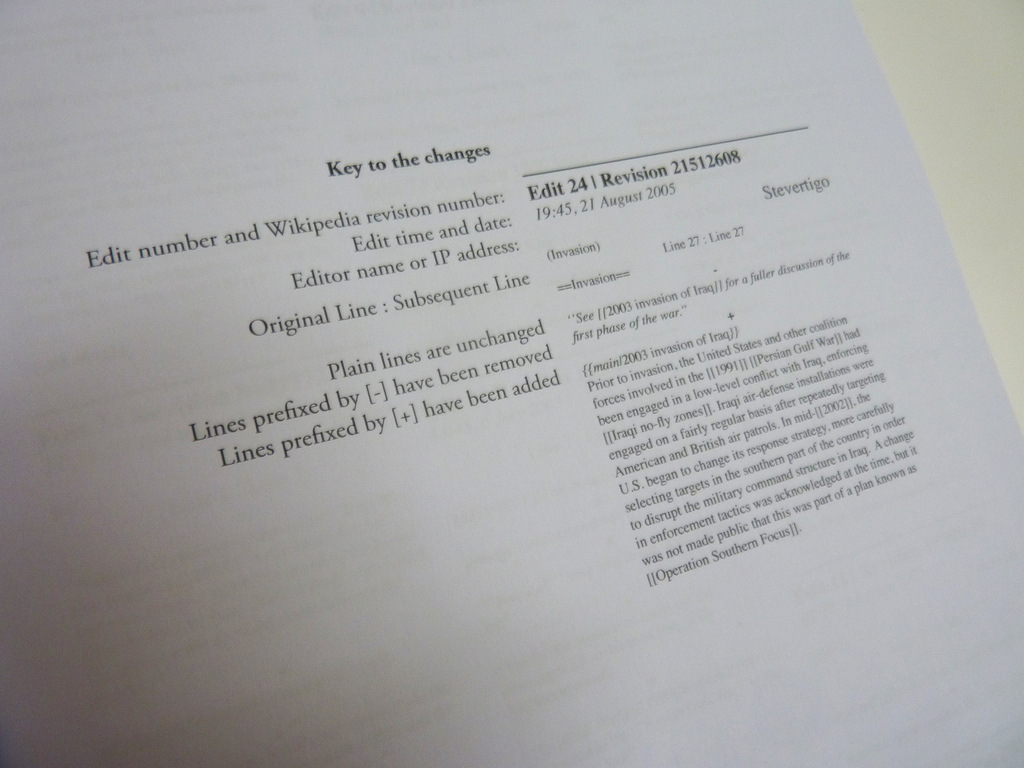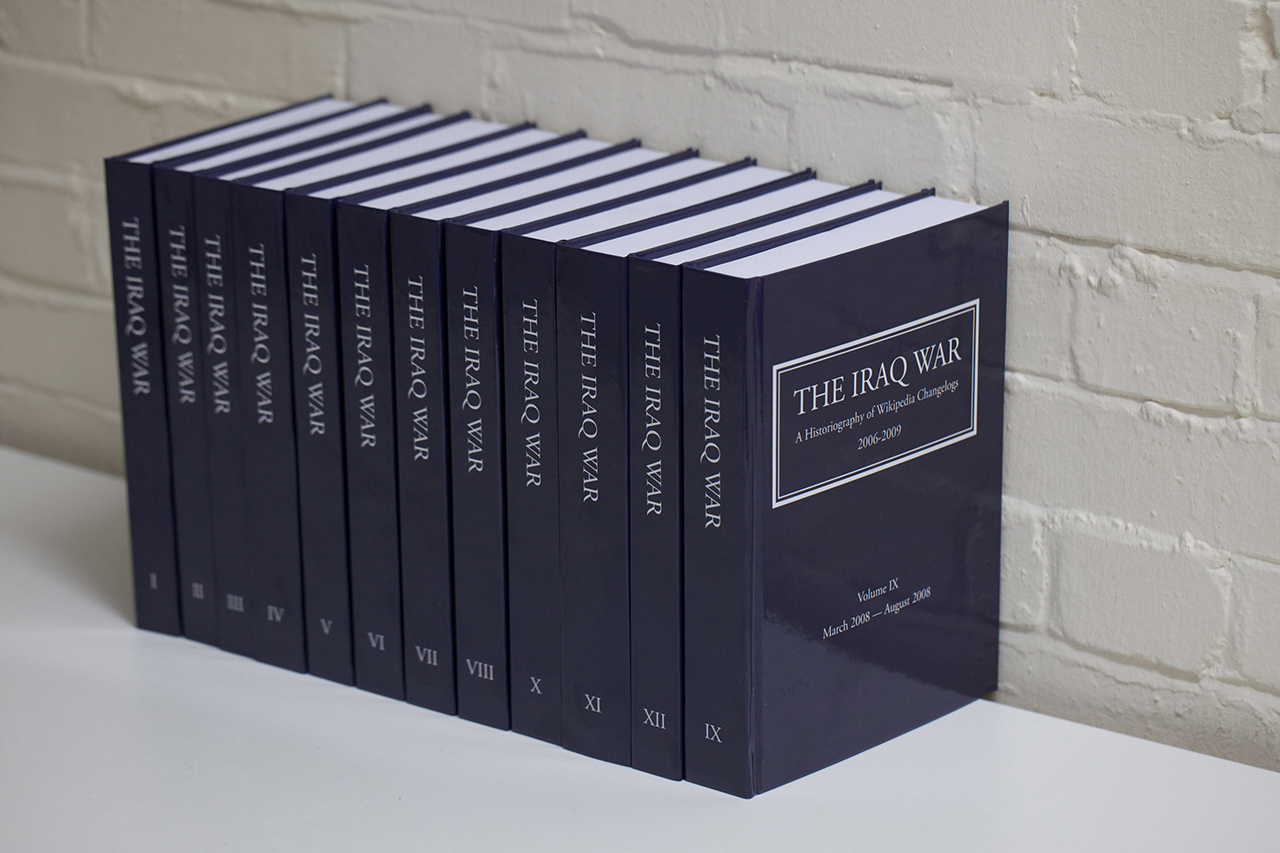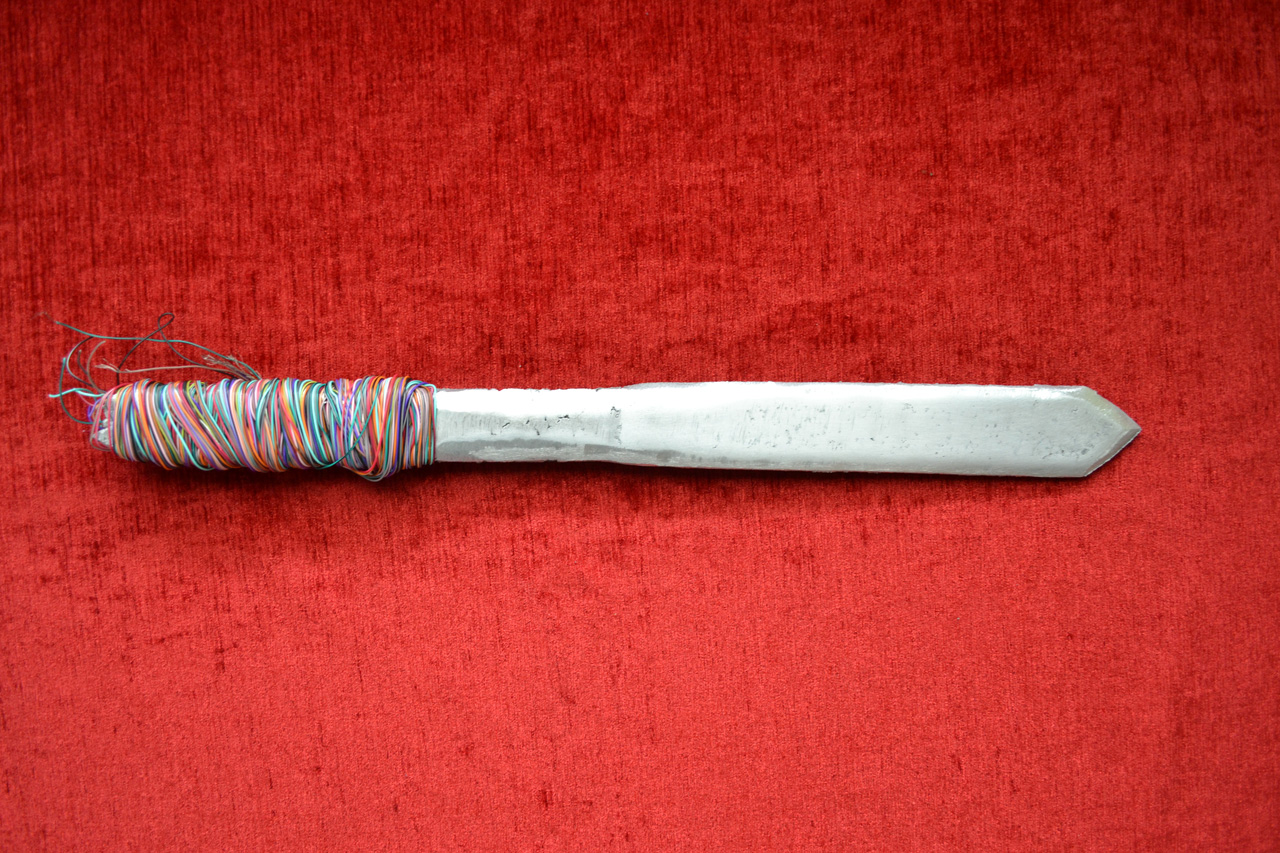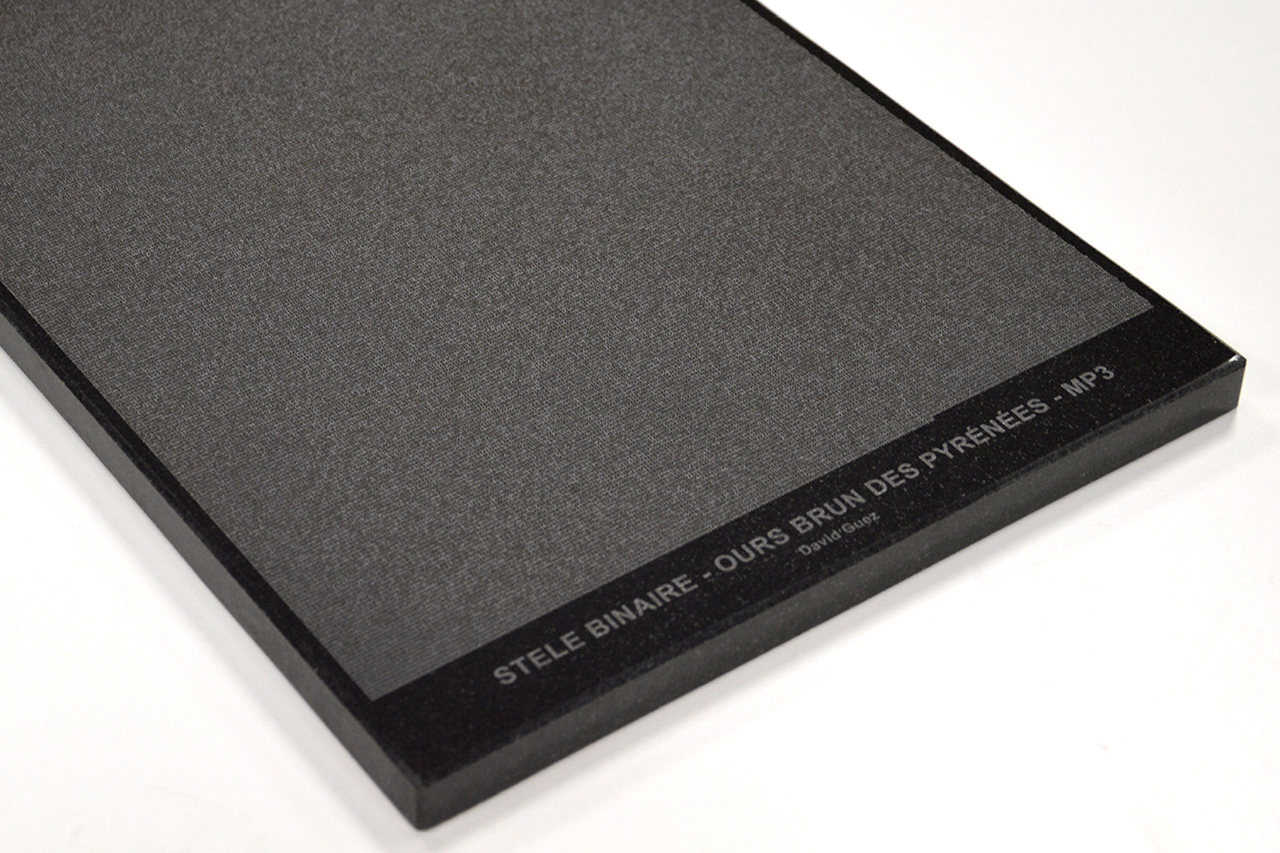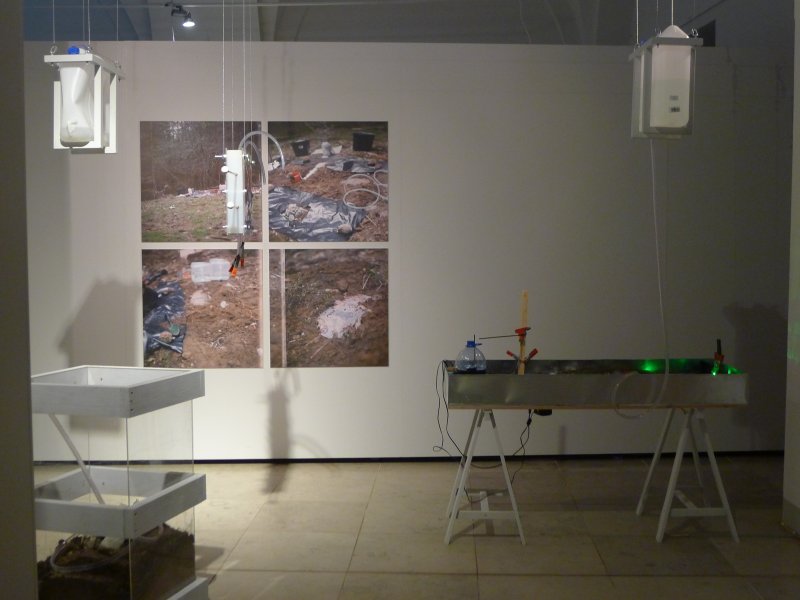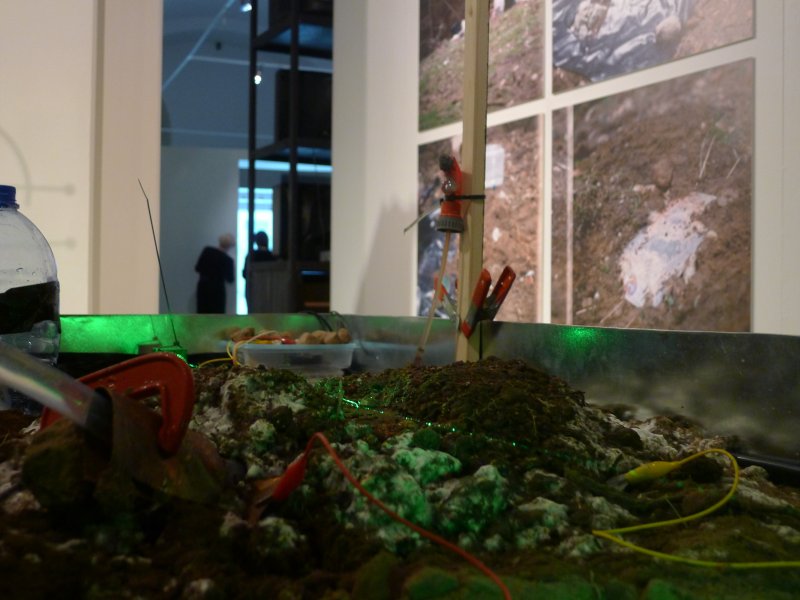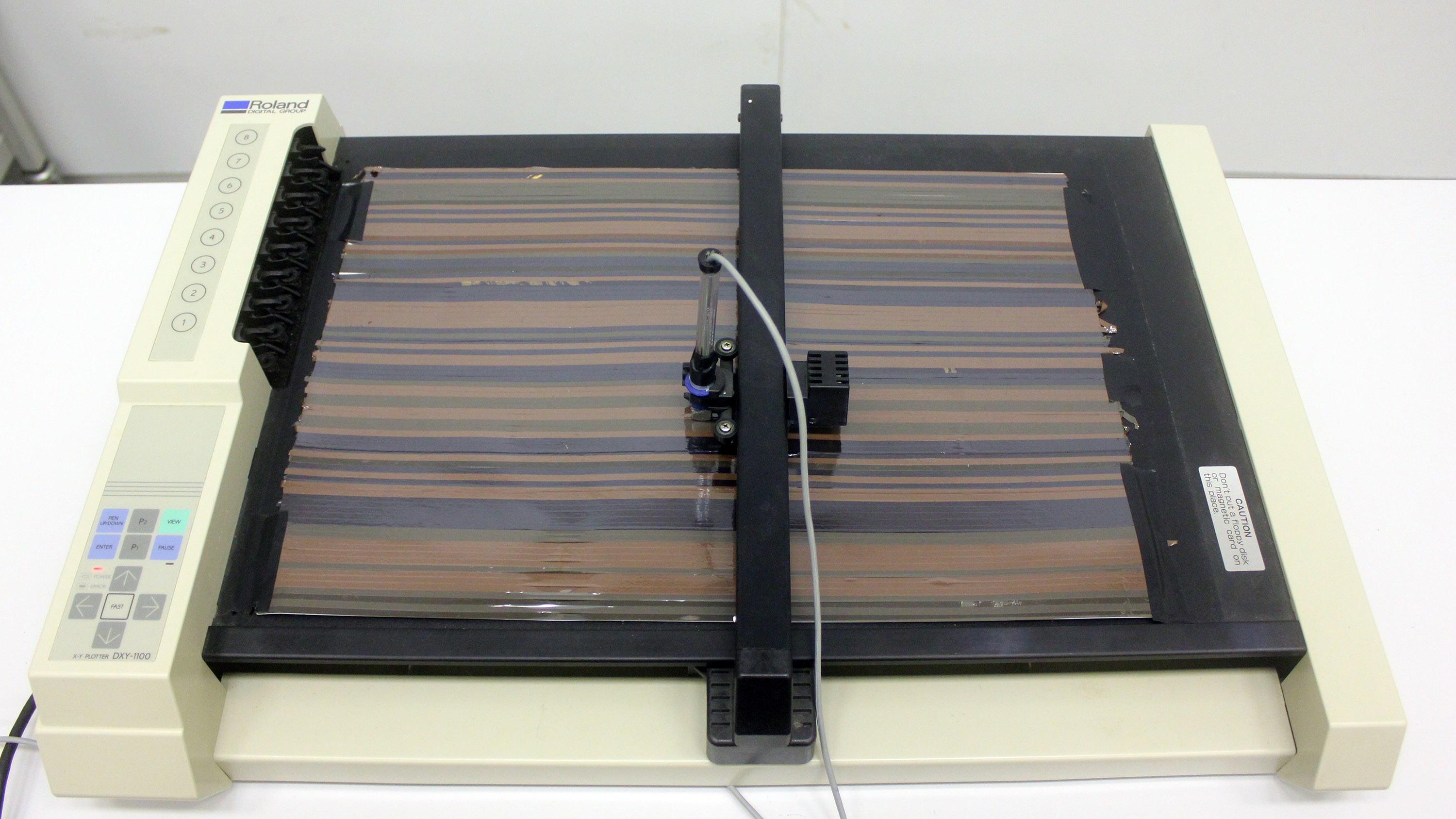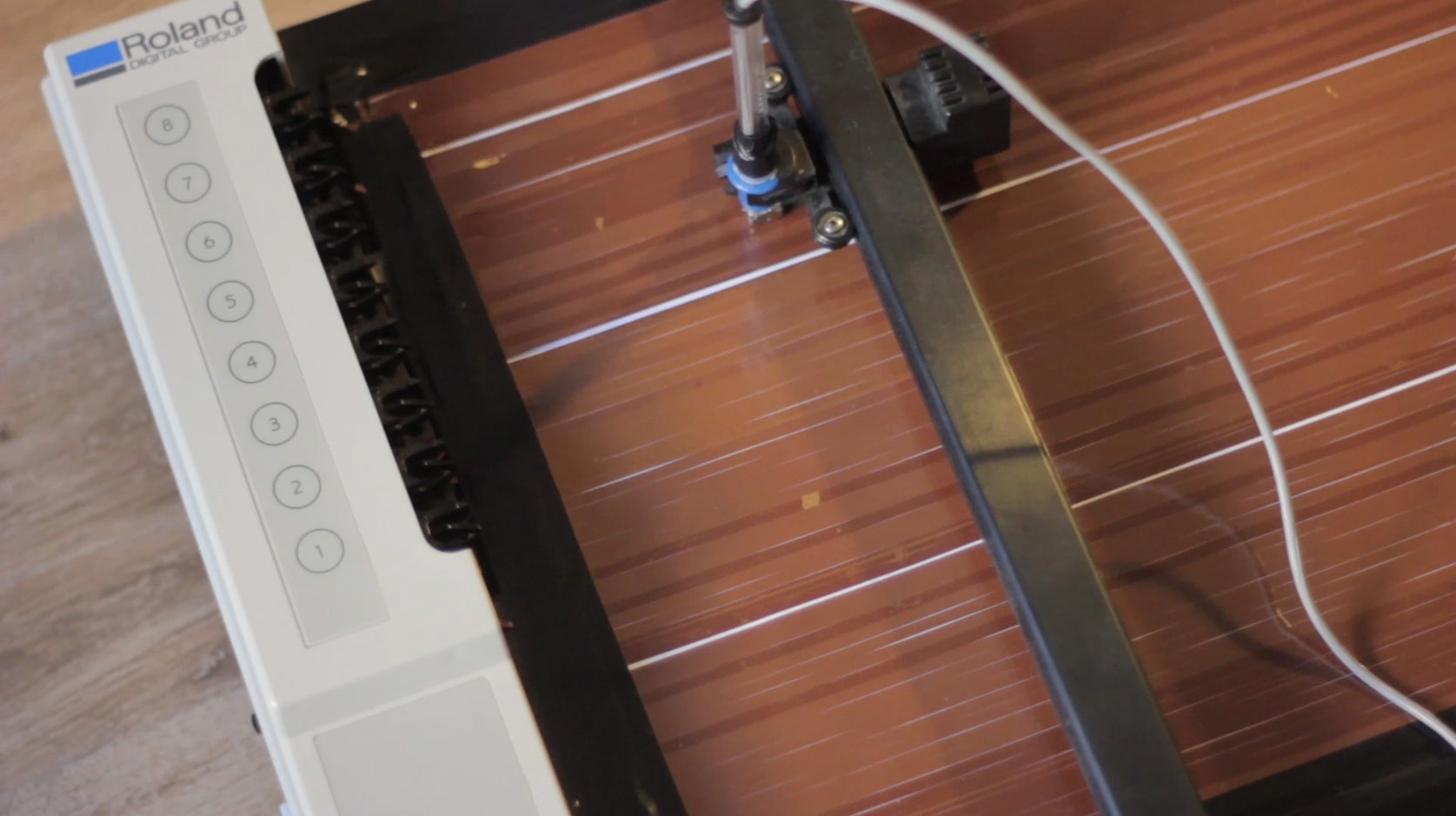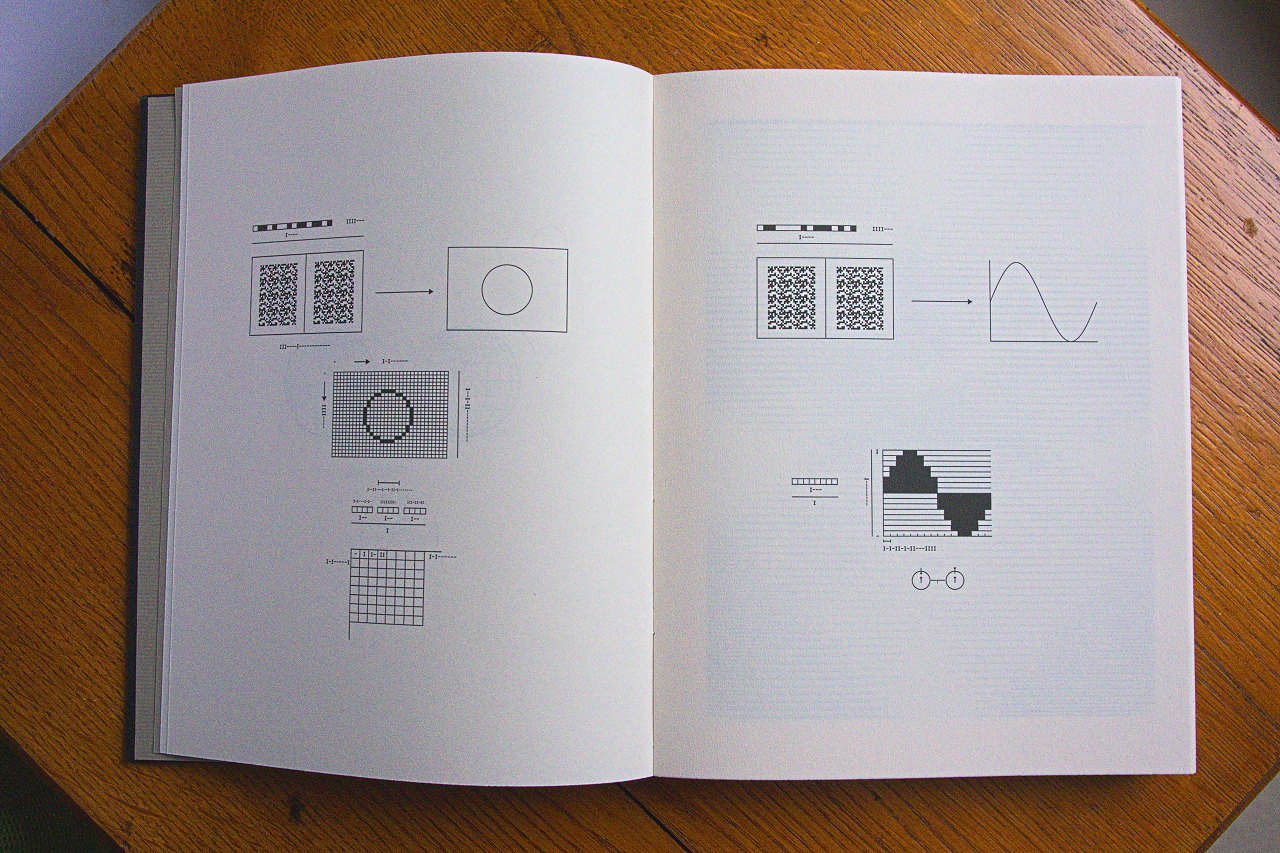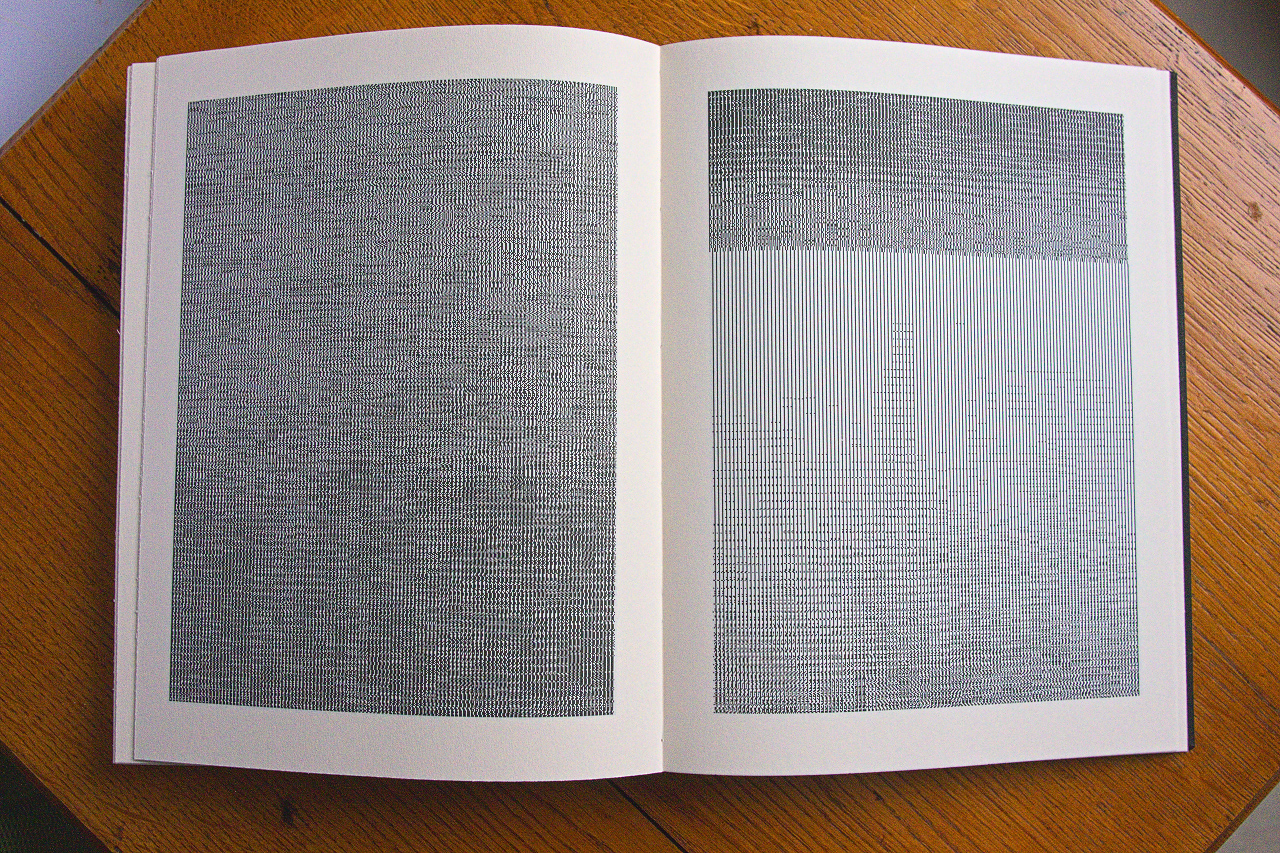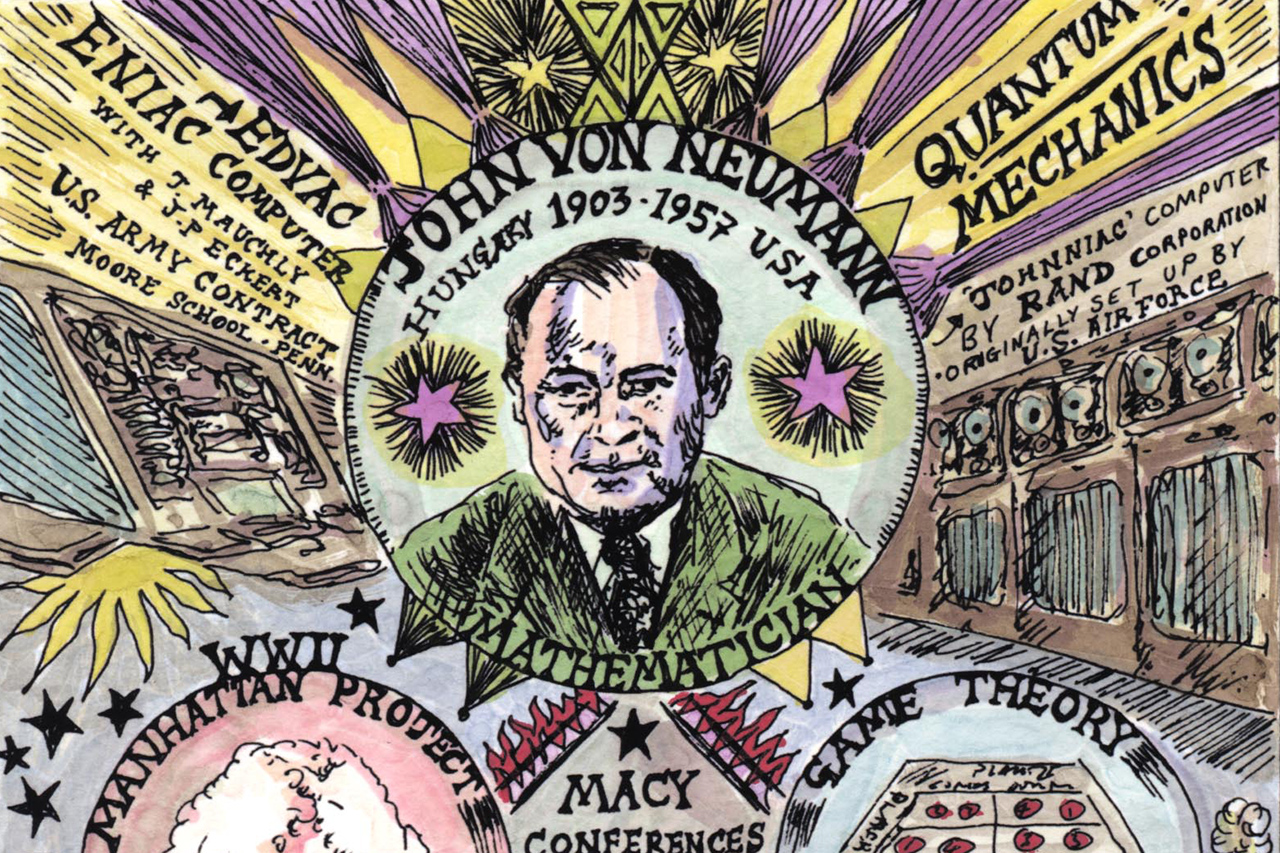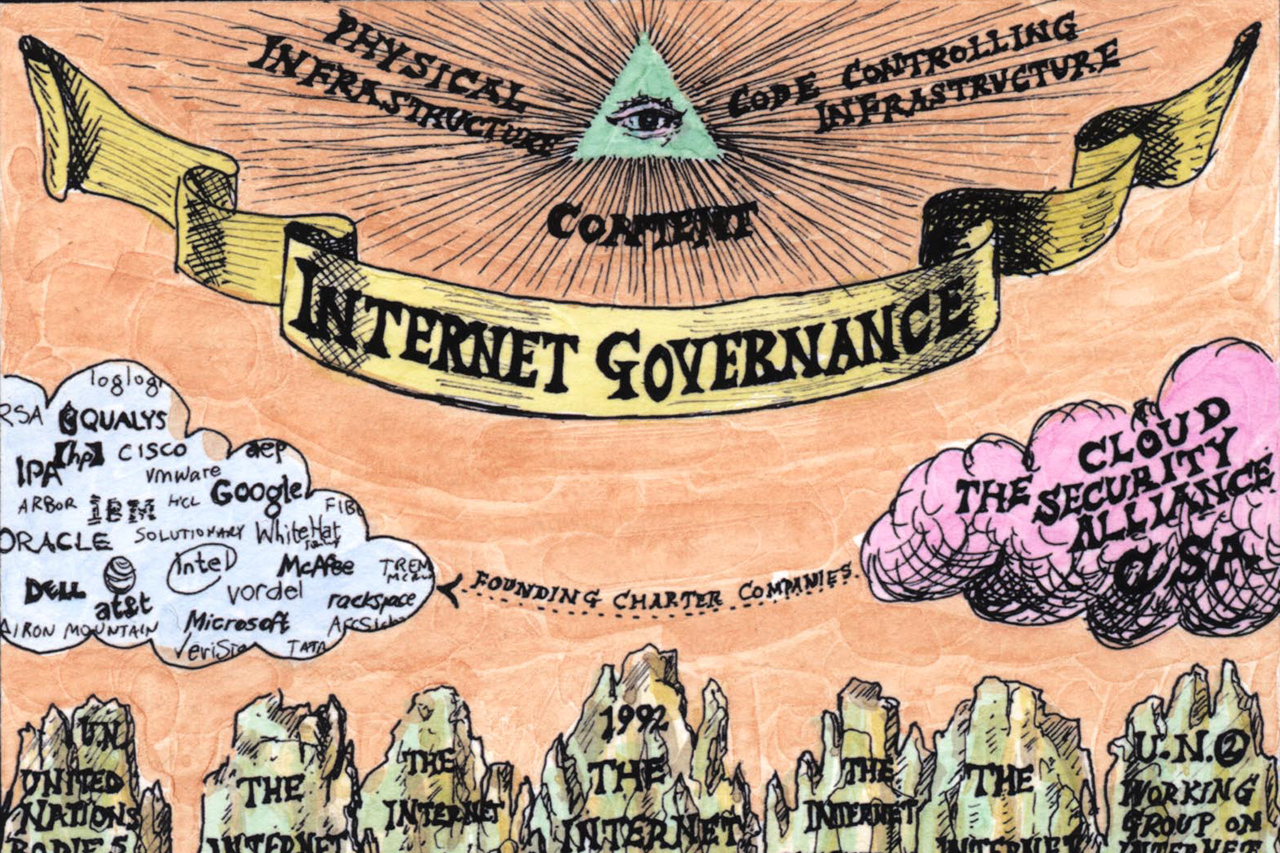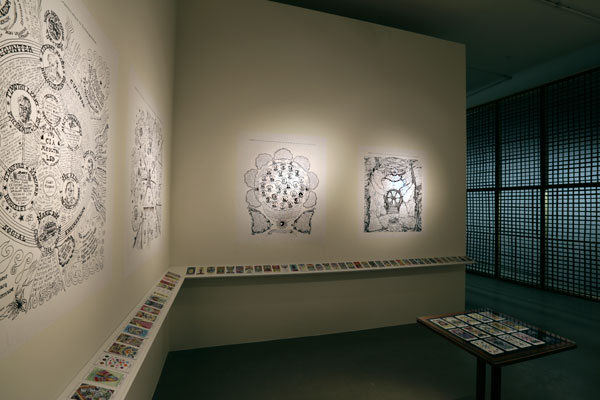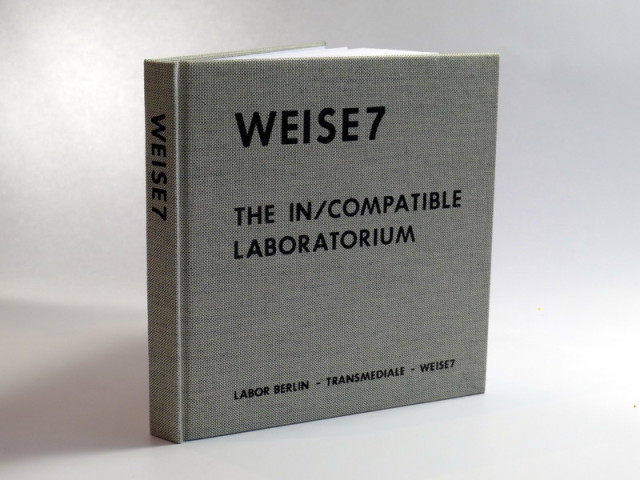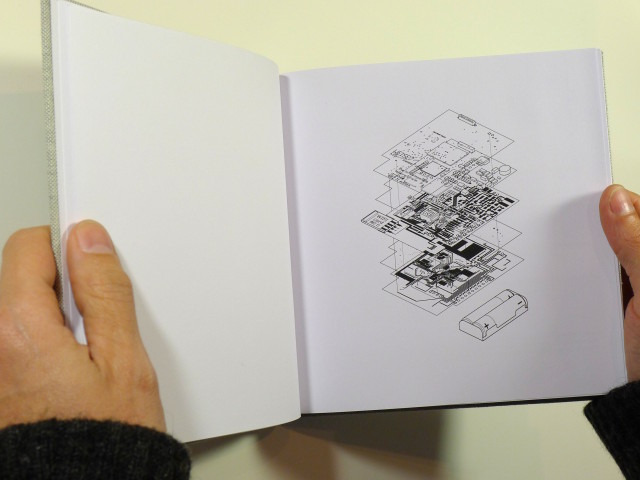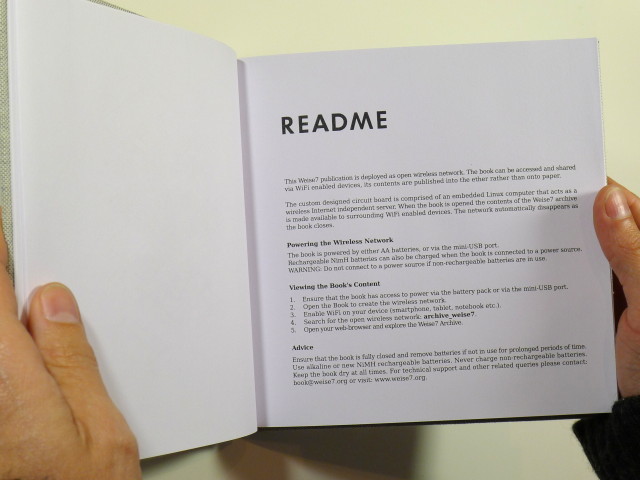Anarchronism
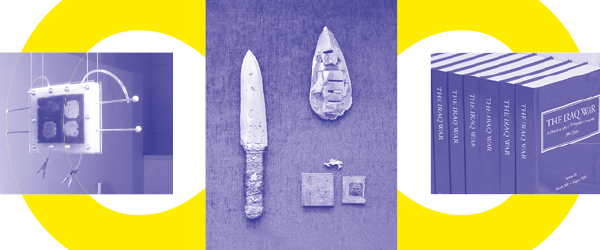
The artworks
The installation "Copies Non Conformes* (Certified Inaccurate)" (2013-2014) explores the erosion and mutations that take place in the reproduction of small sculptures of the 17 letters in the sentence : "JE NE DOIS PAS COPIER" (“I must not copy”). This line is inspired by the punishment commonly meted out to schoolchildren, who are ordered to copy fifty or a hundred times by hand prescriptions and proscriptions like “I must not talk in class”. In this case, the prohibition is not copied by hand, but by a digital duplication process : each letter is modelized and printed in 3D, then the resulting object is digitized by a 3D scanner. This new model is reprinted, and so on and so forth, a certain number of times in a row. Because each subsequent generation accentuates the previous morphological alterations, the last reproductions become unrecognizable.
"Copies Non Conformes" diverts the printer and scanner from their usual functions, using them instead to generate shapes unobtainable in any other way. And through the random distortion of the letters, information is either added or lost at each stage.
"Copies Non Conformes" might be glossed as expressing one of the paradoxes of our digital culture : on the one hand, we have the endless reproduction of information, and on the other, the physical media carrying that information (CDs, hard drives etc.) – and hence the information itself – are becoming increasingly fragile. "Copies Non Conformes" is in this sense a vanitas, a vision of the digital world in ruins – rather like Hubert Robert’s Vue imaginaire de la grande galerie du Louvre en ruines, which he painted in 1796, the year the Louvre was closed due to structural defects only three years after the museum first opened to the public.
* The title of this piece is taken from the french translation of the title of a short story by Philip K Dick : Pay for the printer (1956).
Production Les Ondes with the support of Pôle numérique - ENSBA Paris (2013), Goldsmiths University of London - Department of computing (2014) and Espace Jean-Roger Caussimon (2015). Special thanx to Vincent Rioux, Vladimir Hermand, Atau Tanaka & Jocelyne Quélo.
About the artist:
Cécile Babiole (FR) is a french artist based in Paris. In the 80s she is first active in the music field, then in electronic and digitals arts. Her creations combine visual and audio arts through installations and performances that investigate digital medias with irony. Image, sound and interactivity are the components of her practice. From performance dispositive to participative installations, her recent work concentrate more on technology issues. She aims to transpose and twist around the standardised uses in the field of creation. The industry and apparatus appears like a common thread running throughout all her work : engines or sewing machines concerts, installations on a bus or in a mine, digital making. Cecile Babiole integrates the field of mechanical device and mass culture to draw a confrontation between creativity and determinism, past and present usage, obsolete and contemporary techniques.
Her work has been exhibited internationally : Centre Pompidou Paris, Mutek - Montreal Elektra, Fact Liverpool, MAL Lima, NAMOC Beijing... and distinguished with numerous awards and grants : Ars Electronica, Locarno, prix SCAM, bourse Villa Médicis, Transmediale Berlin, Stuttgart Expanded Media Festival...
She is also a member of the artists-curators collective Le sans titre.
"Trace II" (2012) is a sculptural device that alludes to scientific discoveries and the experimental apparatus of science. Like Trace I (2008), it is essentially a mechanical computer tnat draws its analogue program from a revolving plaster head. The carefully balanced mechanism slowly measures the topography of a cast human head and translates its undulations onto a rotating cylindrical surface. The result is an evolving topographical diagrammatic depiction that is truly unique. The work alludes to medical advances that brought well-recognised depictions such as DNA profiling, MRI scans and 3d scanning (popularised by 3d printing). Trace II investigates the process behind the image making and reconnects the viewer in a tangible way with the process behind these fantastic images. Trace II is not only a drawing machine that 'draws' emphasis on the human condition but also questions our ability to understand the ever increasing advances in technology around us. Trace II, uses the more visually transparent and less alienating technology of the past - more likened to the nature of the fingerprint - to allude to technology of the present.
About the artist:
Bálint Bolygó was born in Pécs (HU), in 1976, where he spent his early childhood years, before moving to the UK at the age of nine. He graduated with an MA in Fine Art at Edinburgh University in 2001. His early work already attracted public attention at the Royal Academy Summer Exhibition in 1999. His first major show in London was a collaborative Group Show with David Mach RA at A.T.Kearney Ltd., Berkeley Sq in 2002. In the same year he was selected for the Bloomberg New Contemporaries exhibition at the Barbican’s Curve and the Liverpool Biennial. His first Solo exhibitions in London included ‘Soft Machines’ at the Hiscox Art Projects in 2003 and ‘Mappings’ at the Long and Ryle gallery in 2005. He worked at Antony Gormley’s Studio, for over five years whilst he moved to London and established his own studio in East London.
Since 2006, Bolygó’s continuous involvement with London’s Kinetica Museum, has led to numerous exhibitions in London and abroad, that include ‘Magnetic Visions’, ‘Universal Man’, and ‘Creatures Great and Small’ and ‘Mind over Matter’. He is an active member of the International Kepes Scociety dedicated to light art, and continues to exhibit internationally and with the organisation.
His Italian exhibition’s include the prestigious San Fedele Art Prize, Milan (2008), sculpture biennial of Piemonte, Turin and Kinetic Step at Step 09 art fair, 2010 Milan. Other international exhibitions include a solo show at Budapest’s Feszek Club 2009, Locus Solus, Benaki Museum Athens 2010, Vienna Art Fair 2009/2010 and a commission for the Lightwaves Festival in Dublin’s Science Gallery 2009. His work ‘Polycycle’ has also been selected for the Hybrid Art Moscow in 2011.
In the summer of 2010, he unveiled an ambitious permanent light installation ‘Aurora’ for the newly opened five-star Town Hall Hotel in East London. This was followed by another major light sculpture commission for London’s Canary Wharf tower in 2013.
Bolygo’s international acclaim lead him to Boston in the Autumn of 2013 where he had two simultaneous solo exhibitions at Huret & Spector Gallery and Boston Cyberarts gallery. Bolygó lives and works in London.
"The Iraq War: A History of Wikipedia Changelogs" (2010) is a twelve-volume set of all changes to the Wikipedia article on the Iraq War.
The twelve volumes cover a five year period from December 2004 to November 2009, a total of 12,000 changes and almost 7,000 pages.
The set is part of a project exploring history and historiography facilitated by the internet, and visualising information, opinion, narrative and discussion.
About the artist:
James Bridle (UK) is an artist, writer, journalist, and publisher from London, UK. His writing on literature, culture and technology has appeared in magazines and newspapers including Wired, Domus, Cabinet, the Atlantic, the New Statesman, the Observer and many others, in print and online. He makes artworks and installations which have been commissioned and exhibited worldwide and on the internet. He regularly speaks at universities, conferences and other events. His formulation of the New Aesthetic research project spurred debate and creative work across multiple disciplines.
James has received an Honorary Mention at the Prix Ars Electronica 2013 and an Excellence Award from the Japan Media Arts Festival 2014. He has been shortlisted for the Future Generation Art Prize 2014 and won the Design Museum Graphics Design of the Year 2014.
"Refonte" (2014) is a series of basic spears and weapons, made from different electronic waste materials. The scrap metal was melted and poured into molds, echoing the ancient techniques of making primitive weapons, made of copper alloys, aluminum and gold. Between contemporary archeology and anachronistic gesture, these weapons offer a redesign of our industrial societies, a post futuristic evocation reminding us about the fragility of our systems and the warlike involvement of humanity.
These weapons suggests a radical change of direction: transforming our technology into primitive tools, placing man before his first nature, bringing the citizen back to the Bronze Age, opposing the state of nature to the social state, in a fierce contemporary "technology war".
Concept: Quentin Destieu, Sylvain Huguet, 2014
About the artists:
The Dardex artists’ collective (FR), was founded in 2003 by Quentin Destieu and Sylvain Huguet while students at the Art School of Aix-en-Provence.
Their collaborative works, involving various other artists and researchers, take the shape of installations and multimedia performances making use of interactivity and real time in the field of media arts. Mainly re-using existing materials, their artistic strategy is based on the ideas of appropriation and hacking. Their work question with sarcasm our “media and technology saturated world”, exploring the borders and relations between technology and popular culture.
Dardex are the founding members of M2F Creations and GAMERZ Festival. They regularly present their works in various exhibitions and festivals in France and abroad.
Binary stele carved in granite stone. Binary code files from various data, here the MP3 sound file of the growl of a bear living in the Pyrénées, France ("grognement de l'ours brun des Pyrénées"), 2014. Thus, a backup plate becomes a storage in case of disappearance.
Concept & realization: David Guez / Co-production: Accès(s) Cultures Electroniques
About the artist:
Since 1994, David Guez (FR) created art work related to new media and digital forms – performances, installations, objects, web site – All his projects are driven by two main otions : « link » and « public ». These two approaches enabled him to create « objects » and « matrices» that question contemporary subjects and their application or their link with new technologies. He deals with topics as varied as free media, psychoanalysis, time, collective uses of the internet, identity problems and loss of liberty.
His last project deals with memory and time : Serie 2067, Humanpedia, paper hard disk, Standard Kilo-Byte, Cam2067, Binaries steles. His work is presented in national and international contemporary artistic networks (France – Gaité lyrique, Centre pompidou, Le plateau, Centre Barbara, Nuit blanche Paris, Beaux arts de Lyon, Dijon, Nantes, résidence au Banff, File Festival Brésil, isea2009/2014…, Canada, USA, Switzerland, Germany, Netherlands…) and has received a broad press coverage (New York Times, Libération, Le Monde, Télérama, France Culture, France Inter…) as well as several prices and grants (Scam, CNC, DAP ).
"Sketches for an earth computer" (2014) presents a series of living "laboratory" studies alongside photographic documentation of various attempts to implement a literal, artistic investigation of the links between the earth, code and the human psyche of the viewer.
The earth computer proposes the bootstrapping of a long-term, visible computational device self-constructed solely from the earth, and embedded within the earth as a critical monument to human technology.
The total environment (geophysical, biological, electro-chemical) itself encodes and manipulates active, new computational-crystalline structures which compute, impact on and re-code this environment within a complex feedback system.
The living "lab" studies consist of a series of containers which explore within an intentionally restricted, demarcated environment the various coded and energetic transformations which the earth computer enacts. These containers are open to, and influenced by local environmental and electromagnetic changes; these changes visibly re-code the enclosed substrates.
With thanks to Daniel Belasco Rogers for casting help and all at RIXC, Rhizope and Neue Heimat!
About the artist:
Martin Howse’s (UK/DE) work spans the fields of computing programming, writing, education and performance. A true explorer of urban scapes, his ideas consider our intimate and embodied relationship with our environment. His work has been received several awards (including first prize at Art & Artificial Life competition VIDA 8.0, 2005) and he has curated and participated in several seminars and performances (ICA, London, Transmediale, Berlin, Tuned City, Berlin & Brussels). In 2006 Martin co-founded xxxxx, organising one large-scale conference and concert series in London (xxxxx) and publishing the acclaimed xxxxx [reader]. From 2007 to 2009 he has hosted a regular workshop, micro-residency and salon series in Berlin, most recently under the banner of _____-micro-research. More recently micro-research has been established as a mobile platform for psychogeophysical research with ongoing projects in London, Peenemuende, Lyme Regis and Berlin. For the last ten years he has collaborated on numerous open-laboratory style projects and performed, published, lectured and exhibited worldwide.
"1.8s" (2014) by Flo Kaufmann is a series of discs, engraved in porcelain. The title refers to the time required for a 33 rpm vinyl record to rotate on the turntable. Flo Kaufmann created a medium, a new and durable support, that plays with a long-term access to information on analog and digital media, commercial and professional, which are found in archives, flea markets and garbage cans. But these discs, shown static or in motion, can presently not be read on any device. Maybe someone will invent one in order to be able to read these discs. "1.8s" is also a wink to the golden records that were send into space with the Voyager, on which a series of sounds that represents Earth were recorded.
About the artist:
Flo Kaufmann (CH) lives and works in Solothurn, Switzerland as "bricoleur universal". He is mainly interested in electronic experimental music, sound and video installations.
"LogforData" (2015) is a cassette composed of several audio encoding protocols: a 56k modem, a fax machine, vintage pc's. These sound data contain the transcriptions of secured conversations between several members on an IRC channel. The decoding of the content is made possible by connecting a cassette player to a computer connected to logfordata.net. A personal version of the text is based on the accuracy of the cassette player, the computer's speed and its connection. The tape contains 15 minutes of audio streams per side, one in French and one in English. The decrypted texts give us a glimpse of the existence of a world, a real data ecosystem where information has mutated into a form of independent living.
A work by Jean-François Blanquet, David Olivari, Clément Charmet, Jérôme Blanquet and Sylvain Le Beux.
About the artist:
Jean-François Blanquet (FR/BE) developed several projects, in which he combines sound and visuals by using specific processes such as transmission/wave reception (radio, infrared, wifi), electronic feedback and larsen (mixer + effects, computer, speaker + microphone), modification and appropriation of audio and video objects (circuit-bending), voice and cut-up (work on text, words and language). In his performances, he recycles technology and develops processes involving loops, larsens, re-injections of the signal and other chain reaction devices.
Jean-François Blanquet often works together with poets, video makers and musicians on multidisciplinary projects and is part of projectsinge group and DEMOLECULARISATION.
This prototype electro-mechanical sound device is based on the Roland DXY pen plotter, a discontinued printing technology of the 1980s, which is combined with audio cassette tape technology in order to playback prerecorded ‘found’ sound recordings from a magnetically encoded audio tape surface. The resulting installation is a multi-temporal assemblage of these marginalised technologies, a hybrid sonic drawing device able to recall and explore archival media. Within these recordings, existing narratives are disrupted and fragmented, straying from chronological order into non-linearity. This draws on analogies to both the device’s merged hardware assembly and to the ‘media archaeological’ interweaving of media timescales and histories.
The REMAP project (2014) engages with obsolete media artefacts and technologies, with an intention to use such past mediatic devices to help critique the impact of current globalised digital and technological consumerist culture. It seeks to explore the notion ‘Zombie Media’ (Parikka/Hertz), ‘the living dead of media culture’, an accumulated mass of discarded waste electronics and a continued physical existence beyond obsolescence.
REMAP (Roland Electro-Mechanical Audio Plotter) is a project by UK artist duo Signal-to-Noise, Oliver Wilshen and Niall Quinn.
About the artists:
The collective Signal-to-Noise (Oliver Wilshen and Niall Quinn, UK) explore the materiality of dead media artefacts. Their work is manifested through direct and playful interaction. The duo create unconventional instruments that question the nature and meaning of performance, originality and memory.
In 2013, they were awarded first prize for the “Interfaces” Interactive Art Competition from the Research Centre for Science and Technology of the Arts (CITAR) in Porto, Portugal. They have exhibited both nationally and internationally including the The National Art Center, Tokyo, EPCOR Centre for the Performing Arts, Calgary and The Victoria & Albert Museum, London. Published work has also appeared in ‘A Touch of Code: Interactive Installations and Experiences’ (2011 Gestalten) and more recently in ‘The Creators Project’ (2013 Intel/Vice).
The "SKOR Codex" (2012) is a printed book which will be sent to different locations on earth. It contains binary encoded image and sound files selected to portray the diversity of life and culture at the Foundation for Art and Public Domain (SKOR), and is intended for any intelligent terrestrial life form, or for future humans, who may find it. The files are protected from bitrot, software decay and hardware failure via a transformation from magnetic transitions on a disk to ink on paper, safe for centuries. Instructions in a symbolic language explain the origin of the book and indicate how the content is to be decoded. La Société Anonyme noted that "the package will be encountered and the book decoded only if there will be advanced civilizations on earth in the far future. But the launching of this 'bottle' into the cosmic 'ocean' says something very hopeful about art on this planet." Thus the record is best seen as a time capsule and a statement rather than an attempt to preserve SKOR for future art historians.
More on how it works on log.bleu255.com/.../electronic-publishing-one-bit-at-a-time/
About the artists:
La Société Anonyme (NL) is an artist’s collective born from the ashes of the Dutch 2013 funding cuts to the arts. An avant-garde art collective with a corporate twist après la lettre, La Société Anonyme launches its first product in July 2012: The SKOR Codex, a book preserving the legacy of one of the Netherlands' perishing art organisations for the distant future. Adopting an experimental model of artistic corporation, La Société Anonyme responds to the commodification of culture by searching for alternative ways to make, promote and sustain art. La Société Anonyme is represented by Dušan Barok, Danny van der Kleij, Aymeric Mansoux and Marloes de Valk.
"HEXEN 2.0" (2009-2011) looks into histories of scientific research behind government programmes of mass control, investigating parallel histories of countercultural and grass roots movements. "HEXEN 2.0" charts, within a framework of post-WWII U.S. governmental and military imperatives, the coming together of scientific and social sciences through the development of cybernetics, the history of the internet, the rise of Web 2.0 and increased intelligence gathering, and implications for the future of new systems of societal manipulation towards a control society.
"HEXEN 2.0" specifically investigates the participants of the seminal Macy Conferences (1946-1953), whose primary goal was to set the foundations for a general science of the workings of the human mind. The project simultaneously looks at diverse philosophical, literary and political responses to advances in technology including the claims of Anarcho-Primitivism and Post Leftism, Theodore Kaczynski/The Unabomber, Technogaianism and Transhumanism, and traces precursory ideas such as those of Thoreau, Warren, Heidegger and Adorno in relation to visions of utopic and dystopic futures from science-fiction literature and film.
Based on actual events, people, histories and scientific projections of the future, and consisting of alchemical diagrams, a Tarot deck, photo-text works, pencil drawings, a video and a website, "HEXEN 2.0" offers a space where one may use the works as a tool to envision possible alternative futures.
"HEXEN 2.0" is the sequel to "HEXEN 2039" which imagined new technologies for psychological warfare through investigating links between the occult and the military in relation to histories of witchcraft, the US film industry, British Intelligence agencies, Soviet brainwashing and behaviour control experiments of the U.S. Army.
About the artist:
Suzanne Treister (b.1958 London UK) studied at St Martin's School of Art, London (1978-1981) and Chelsea College of Art and Design, London (1981-1982) based in London having lived in Australia, New York and Berlin. Initially recognized in the 1980s as a painter, she became a pioneer in the digital/new media/web based field from the beginning of the 1990s, making work about emerging technologies, developing fictional worlds and international collaborative organisations. Utilising various media, including video, cd-rom (see her resurrected Time Travelling with Rosalind Brodsky cd-rom), the internet, interactive technologies, photography, drawing and watercolour, Treister has evolved a large body of work which engages with eccentric narratives and unconventional bodies of research to reveal structures that bind power, identity and knowledge. Often spanning several years, her projects comprise fantastic reinterpretations of given taxonomies and histories that examine the existence of covert, unseen forces at work in the world, whether corporate, military or paranormal.
"The Weise7 in/compatible Laboratorium Archive" (2012) is a record of the Weise7 Studio show for Labor Berlin 8, a series of workshops run at Weise7 and its own creation.
Unlike other books, this book acts as an Internet independent wireless server, running from a tiny, custom designed computer inside the book.
To start the server just open the book and connect to it wirelessly using your laptop, tablet or phone. Browse the contents in a park, library or while half way up a mountain, sharing the content with those in your vicinity. Inside can be found high resolution images of our exhibition, video, source code and texts about each of the works. To turn off the server, simply close the book..
"The Weise7 in/compatible Laboratorium Archive" was launched on March 9th, 2012 at Labor Berlin at the Haus der Kulturen der Welt, Berlin, and was 5 months in development. The Weise7 Studio show happened in the context of Transmediale 2012 and gathered artworks by Servando Barreiro (ES), Brendan Howell (USA), Julian Oliver (NZ), Gordan Savicic (AT), Bengt Sjölén (SE), Danja Vasiliev (RU).
Exhibition:
15 May - 14 June 2015
Wednesday - Sunday, 13:00 - 18:00
Finissage & performances:
Sunday 14 June
19:30 - 22:30
Free admission!
Group visits
02 410 30 93
info@imal.org
Location: iMAL
30 Quai des Charbonnages / Koolmijnenkaai
1080 Brussels
An archive : 1999-2010-2019
This page is an archive of the iMAL website that operated between 2010 and 2019. It compiles activities and projects made since 1999.
For our most recent news and activities, please check our new website at https://imal.org


